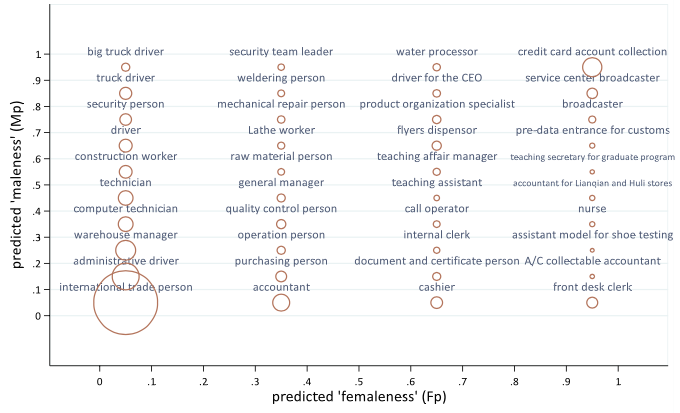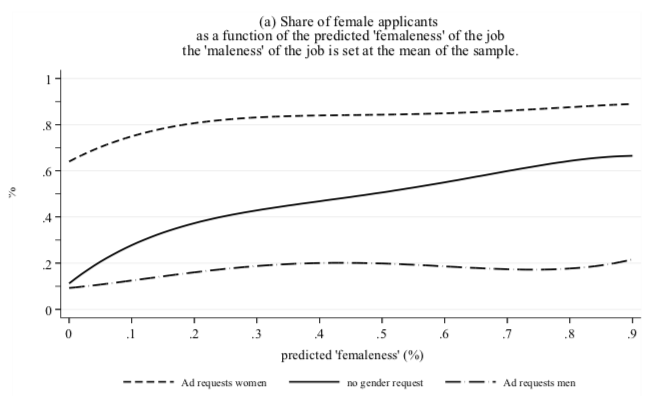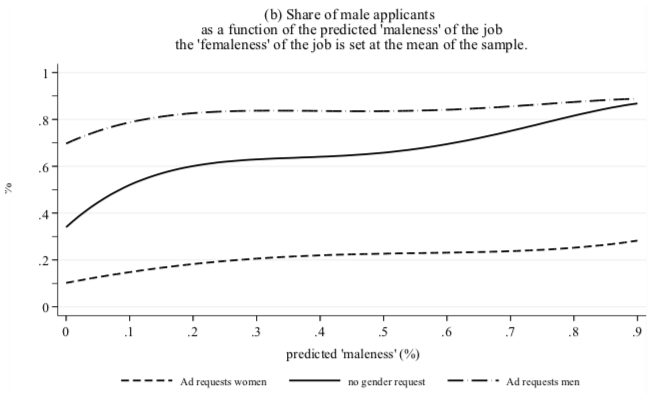
What are the impacts of job advertisements that are targeted at specific genders?
There is a huge literature on gender discrimination and inequality in the labour market (e.g. Blau and Kahn 2017, Goldin 2014). While it is undeniable that the job search and matching process plays a pivotal role in gender inequality in the labour market, there have not been many studies from the search-and-matching perspective due to data availability constraints. However, the increasing usage of online job boards in the recent decade has alleviated such constraints. We use online job board data to examine gender-targeted job adverts in a series of recent studies.
Stating an explicit gender preference
The practice of stating an explicit gender preference in job adverts is widely used in emerging economies. For example, Appendix 1 of Kuhn et al. (2018) shows examples of explicit gender requests from China, India, Indonesia, Brazil, Pakistan, Nigeria, Russia, Mexico, and Japan. Gendered adverts are also easy to find on a number of Latin American websites, including in Colombia, Mexico, Argentina, Peru, and Venezuela. And although gendered job adverts have largely disappeared from national job boards since 2016 in China, such adverts are still common in many local and smaller job boards. Even in countries where gender discrimination is illegal, employers are now able to limit exposure of their job adverts to their preferred worker types with the help of targeted advertising (Angwin et al. 2017). Together, these observations indicate that the intentional targeting of job ads to specific genders and demographic groups demands continuous attention.
When we examine the labour market at a granular level, the agents in the labour market are obviously not matched with each other randomly. Instead, employers and workers strategically search and match over time through a three-stage dynamic process. First, employers decide on the content of job adverts. Then workers decide on the set of jobs to apply to. Finally, employers decide on the set of workers to interview and hire. In this process, employers’ job posting decisions on whether or not to include an explicit gender preference in the job adverts initiates the whole dynamics of gender segregation. The impacts of employers’ gender requests depend on the responsiveness of workers as well as employers’ enforcement at the screening stage.
Four major patterns
Using job posting data from four online job boards (Kuhn and Shen 2013, Delgado Helleseter et al. forthcoming), we establish four major patterns of employers’ explicit gender preferences.
- Symmetry: The shares of job adverts that request men and women roughly equal each other.
- Negative skill-targeting: Job adverts requesting less education and less experience, and offering lower wages, are more likely to express a gender preference. This applies both to requests for men and requests for women.
- Job- (rather than firm-) specificity: It is common for the same employer to request men for some jobs and women for others. The jobs that tend to request men versus women are largely the same across firms.
- The ‘age twist’: As the desired worker age rises between 18 and 45, employers’ advertised gender requests ‘flip’ from strongly favouring women to strongly favouring men. Figure 1 provides descriptive evidence of such age-twist patterns.
Figure 1 The age twist in gender preferences in job adverts

Note: The bars indicate the shares of job adverts requesting women and men in each of the four desired age groups (under 25, 25-29, 30-34, and 35+).
Source: Figure 2 of Delgado Helleseter et al. (forthcoming).
Understanding the age twist
To further understand the age twist in employers’ gender preferences, we use the information contained in job titles as well as nationally representative survey datasets of China and Mexico, and find that:
- 65% of the age twist can be ‘explained’ by age-related changes in the mix of tasks. In particular, employers tend to prefer young women for ‘helping’, customer contact, and administrative occupations, while preferring older men for managerial jobs.
- Employers’ preferences for young women and employers’ preferences for beauty are strongly, and positively correlated.
- Employers’ gender-specific preferences for workers’ marital and fertility status also contribute to the age twist. Specifically, employers prefer single women and women without children, while preferring married men and men with children.
It is worth noting that the four online job boards we study – Zhaopin.com (a national job board in China), XMRC.com (a city level job board targeting white-collar jobs), XMZYJS.com (a city level job board targeting blue-collar jobs), and Computrabajo-Mexico (a national job board in Mexico) – differ substantially in terms of culture, size, and user groups targeted. Nonetheless, evidence from all four of these job boards support the above patterns.
The second and third stages of the search and matching process
Most recently, our investigation shifts to the second and third stages of the search and matching process. It is worth noting that workers’ application behaviour and employers’ job posting and call back behaviour are assumed to depend on each other in our setup. Such assumptions are supported by a number of empirical studies (e.g. Banfi and Villena-Roldan 2018, Niederle and Lise 2007).
Specifically, Kuhn et al. (2018) examine the impacts of employers’ explicit gender preferences and the related mechanisms. Using internal data provided by XMRC.com, they find that:
- 92.4% of applications and 94.8% of call backs to gendered job adverts are from (of) the requested gender.
- When considering all job adverts (whether or not they have explicit gender preferences), 50-60% of the gender segregation among successful job applicants can be accounted for by job adverts’ gender preferences.
Workers’ application behaviour versus employers’ call back behaviour
Our decomposition exercises further suggest that most of the impact of gender preferences can be accounted for by workers' application behaviour, rather than employers’ call back behaviour. While gender-mismatched applicants do suffer from substantial penalties in terms of call back chances, 74% of the observed matching between employer’s gender requests and successful applicants’ gender is due to workers’ self-selection at the application stage.
Since workers may be able to infer job adverts’ implicit gender preferences from job titles, we construct indicators of the predicted, or implicit ‘maleness’ or ‘femaleness’ of the jobs. This is done using machine learning analysis of the words in the job titles.
The job titles with the most applications at different levels of predicted maleness and femaleness are presented in Figure 2. As Figure 2 shows, while “front desk clerks” and “big truck drivers” are typically female and male jobs, respectively, in this market, there are also jobs like “credit card account collection” that are often very explicit in their gender preferences but can prefer females in some postings and males in others. On the other hand, jobs like “international trade person” rarely express an explicit gender preference; thus, the predicted ‘maleness’ and ‘femaleness’ of these jobs are both very low.
Figure 2 Selected job titles, by predicted ‘maleness’ and ‘femaleness’

Note: Symbol size is proportional to the number of unique job titles in the cell. The forty cells in the figure are defined by four predicted ‘femaleness’ ranges ([0, .1], (.3, .4), [.6, .7] and [.9, 1]) and ten predicted ‘maleness’ ranges ([0, .1], (.1, .2), through [.9, 1]).
By taking account of these implicit gender preference indicators, we are able to identify, arguably, the ‘pure’ impact of explicit gender preferences.
Figure 3 Effects of gender requests and predicted gender on female/male share of applicants



Notes: Here, Fp and Mp represent the predicted ‘maleness’ or ‘femaleness’ of the job adverts based on job titles. F, N and M represent job adverts with explicit preference for female, none, and male workers, respectively. These figures represent predicted values of the female (male) share of applicants from a regression of the fe(male) share of applicant on quartics in Fp and Mp and their interactions with F, N and M. Panel (a) shows the effect of implicit femaleness (Fp) on female share of applicants, holding Mp at its mean. Panel (b) shows the effect of implicit maleness (Mp) on male share of applicants, holding Fp at its mean. Panel (c) shows the predicted effects of attaching an explicit male (female) label to a job ad (relative to an N label) at different levels of implicit maleness (femaleness), with 95 per cent confidence bands represented by dashed lines.
Source: Figure 1 of Kuhn et al. (2018).
As Figure 3 shows, we find that:
- Explicit gender preferences are very effective in directing workers’ application behaviour [the F and M lines differ from the N lines significantly in both panels a and b).
- The impacts of job adverts’ explicit gender preferences are stronger when the words in the job titles more strongly suggest the opposite gender for that type of work (the lines in panel c are highest when the predicted likelihood for the job to prefer the other gender is highest).
- Requesting women has a much stronger impact on the female applicant share than requesting men has on the male applicant share (the ‘F versus N’ line is higher than the ‘M versus N’ line in panel c). Relatedly, women are much less likely to apply than men when jobs do not explicitly request their gender (the ‘N’ line is much lower in panel a than in panel b).
The above results echo existing findings that female job searchers are more ambiguity-averse, more uncertainty-averse, and more responsive to affirmative action statements than men (Gee forthcoming, Flory et al. 2015, Leibbrandt and List 2014, Ibanez and Reinter 2018). Overall, our findings provide a rich set of empirical patterns which indicate how the explicit gender preferences of job adverts actually affect the eventual labour market outcomes.
Policy implications
Our findings suggest the importance of reducing barriers that discourage women from applying to certain jobs for gender equality in the labour market. Policies that influence workers’ application decisions may have the potential to be at least as important as policies that target employers’ screening behaviours, if not more.
Specifically, our findings suggest that female job seekers respond positively to more transparent information as well as to encouraging signals in job adverts. Thus, firms could attract more women by crafting job ads that contain such female-friendly information, or at least are not overtly discouraging by inviting men only. In this era of information abundance and overload, both private and public sectors have the potential to provide such information for gender equity in the labour market.
References
Angwin, J, N Scheiber and A Tobindec (2017), “Facebook job ads raise concerns about age discrimination”, New York Times, 20 December.
Banfi, S and B Villena-Roldan (forthcoming), “Do high-wage jobs attract more applicants? Directed search evidence from the online labour market”, Journal of Labor Economics.
Blau, F and L Kahn (2017), “The gender wage gap: Extent, trends, and sources,” Journal of Economic Literature, 55(3): 789-865.
Delgado Helleseter, M, P Kuhn and K Shen (forthcoming), “Age and gender profiling in the Chinese and Mexican labour Markets: Evidence from four job boards,” Journal of Human Resources.
Flory, J, A Leibbrandt and J List (2015), “Do competitive workplaces deter female workers? A large-scale natural field experiment on job entry decisions,” The Review of Economic Studies, 82(1): 122–155.
Gee, L, (forthcoming), “The more you know: Information effects on job application rates in a large field experiment”, Management Science.
Goldin, C (2014), “A grand gender convergence: Its last chapter”, American Economic Review, 104(4): 1091-1119.
Ibanez, M and G Reinter (2018), “Sorting through affirmative action: Three field experiments in Colombia”, Journal of Labor Economics, 36(2): 437-478.
Kuhn, P and K Shen (2013), “Gender discrimination in job ads: Evidence from China”, The Quarterly Journal of Economics, 128(1): 287-336.
Kuhn, P, K Shen and S Zhang (2018), “Gender-targeted job ads in the recruitment process: Evidence from China”, NBER working paper, no. 25365.
Leibbrandt, A and J List (2014), “Do women avoid salary negotiations? Evidence from a large-scale natural field experiment”, Management Science, 61(9): 2016-2024.
Niederle, M and L Vesterlund (2007), “Do women shy away from competition? Do men compete too much?”, The Quarterly Journal of Economics 122(3): 1067-1101.


